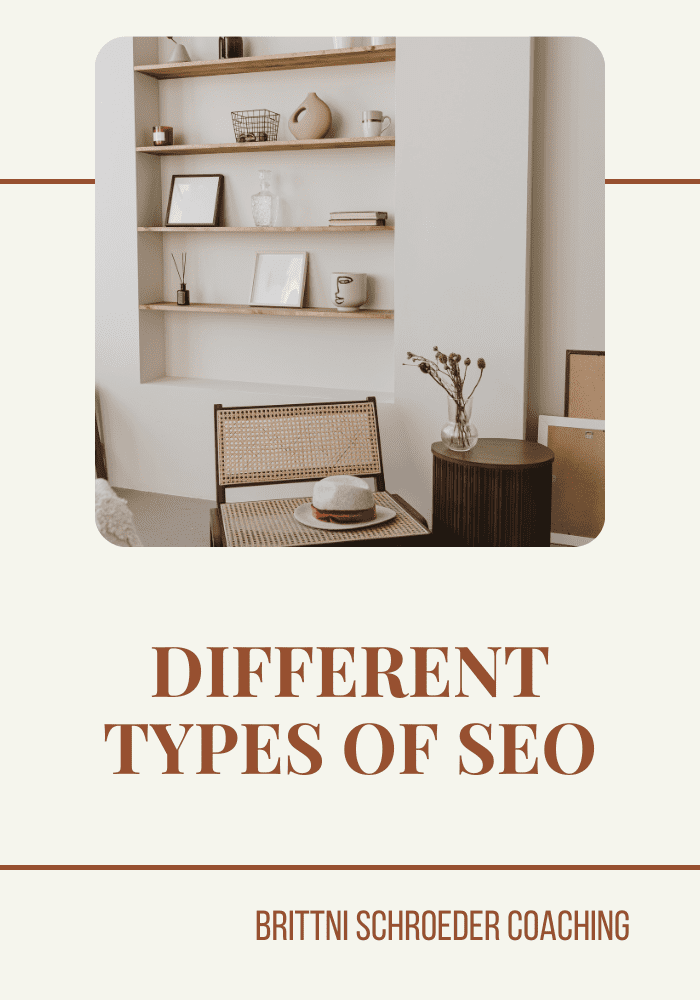brittni schroeder
BLOG
Brittni Schroeder Coaching
DIFFERENT TYPES OF SEO

Search Engine Optimization has several different layers. There are multiple components that contribute to a higher ranking. Learning and implementation of the different types of SEO can make an impact on your business.
TECHNICAL SEO
Technical SEO refers to the process of optimizing your website for the crawling and indexing phase. In other words, Google bots scan your website and then determine how to rank you. Ensuring that your website is optimized will help boost your technical SEO. Making a website faster, easier to crawl, and understandable for search engines are crucial elements for technical SEO.
The technical SEO can be complicated if you are not familiar with web design or coding. If you have knowledge of the website and feel comfortable with the technical aspects, you can find recommendations from several resources.
ON-PAGE SEO
On-page SEO refers to the page itself and how to make it user-friendly and accessible for search engines. Search engines look at your entire website. However, ranking is performed one page at a time. That is why it is important to optimize each page.
On-page SEO refers to implementing appropriate keywords throughout your pages. These keywords are optimized in page titles, H1 Tags (top heading of a page), sub-headings, images, and page formatting.
CONTENT SEO
Content SEO is a subset of on-page SEO. It pertains to the quality of the content and how frequently the content is searched. This the type of SEO that most focus on. Publishing great content that creates value and is searchable by search engines will help improve your SEO.
When you take the time and do effective keyword research, you are able to improve your rankings. By finding SEO keywords and incorporating them into your content, you will have success. This can be achieved by implementing long and short-tailed keywords in your titles, heading, and main content.
Another technique used in SEO content is using inbound and output links. Inbound links allow you to connect content from your other pages and content. Outbound links allow you to link reputable content to support your own content.
OFF-PAGE SEO
Off-Page SEO is about promotion. It has to with techniques and methods you use to promote your website on the internet. Websites that are popular are more likely to rank higher on Google than less popular websites.
The most important off-page SEO methods are link building and brand promotion. These are both done by other websites backlinking (or linking back) to your website. These backlinks increase your authority with Google. Google likes to rank popular websites because others like and trust them. Google rewards websites that people gravitate toward and share.
LOCAL SEO
Local SEO is specifically for local businesses. If you have a website and your goal is to get clients to visit your local store, then you need to focus on local SEO.
Everything mentioned previously pertains to Local SEO with the following additions:
- Detailed business contact details on all pages of your website.
- Create a Google My Business Account
- Register Your Business with a trusted directory such as Yelp, Yahoo, Foursquare and others.
- Promote your website on local directories and websites.
MOBILE SEO
Mobile SEO is another subset specific for mobile devices. It’s proven that more than half of Google searches are performed on mobile devices.
Google has created a mobile-first index. This means that you need to ensure that your website is mobile-friendly. When working on Mobile SEO, make sure the website loads fast and is easy to use navigate on all mobile devices.
ECOMMERCE SEO
eCommerce is becoming more and more popular. When it comes to search engine optimization, optimizing an eCommerce website can be more complicated than a website or blog.
There tends to be more pages and can be more difficult to promote. Some of the most important SEO factors include:
- Optimization of homepage and category pages.
- Optimize product pages.
- Optimize all visual elements.
- Promote your store on social media.
- Discover ways to get people to link to your product pages.
- Start a blog and publish content related to your products.
SEO is one of the most powerful digital marketing tools for your website. When you understand and implement these processes, you will begin to notice improvements in your SEO and in turn, enjoy a stronger brand
